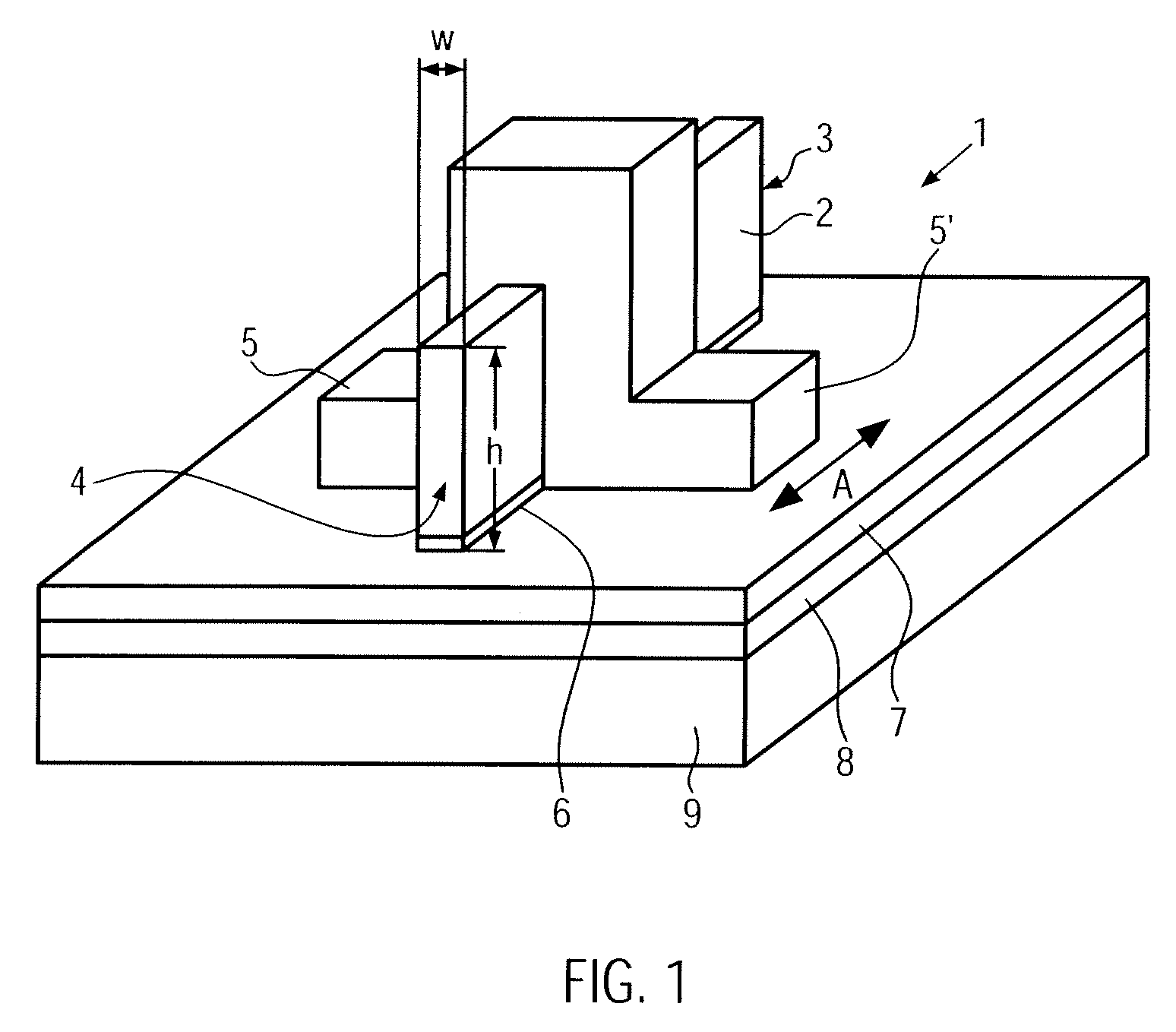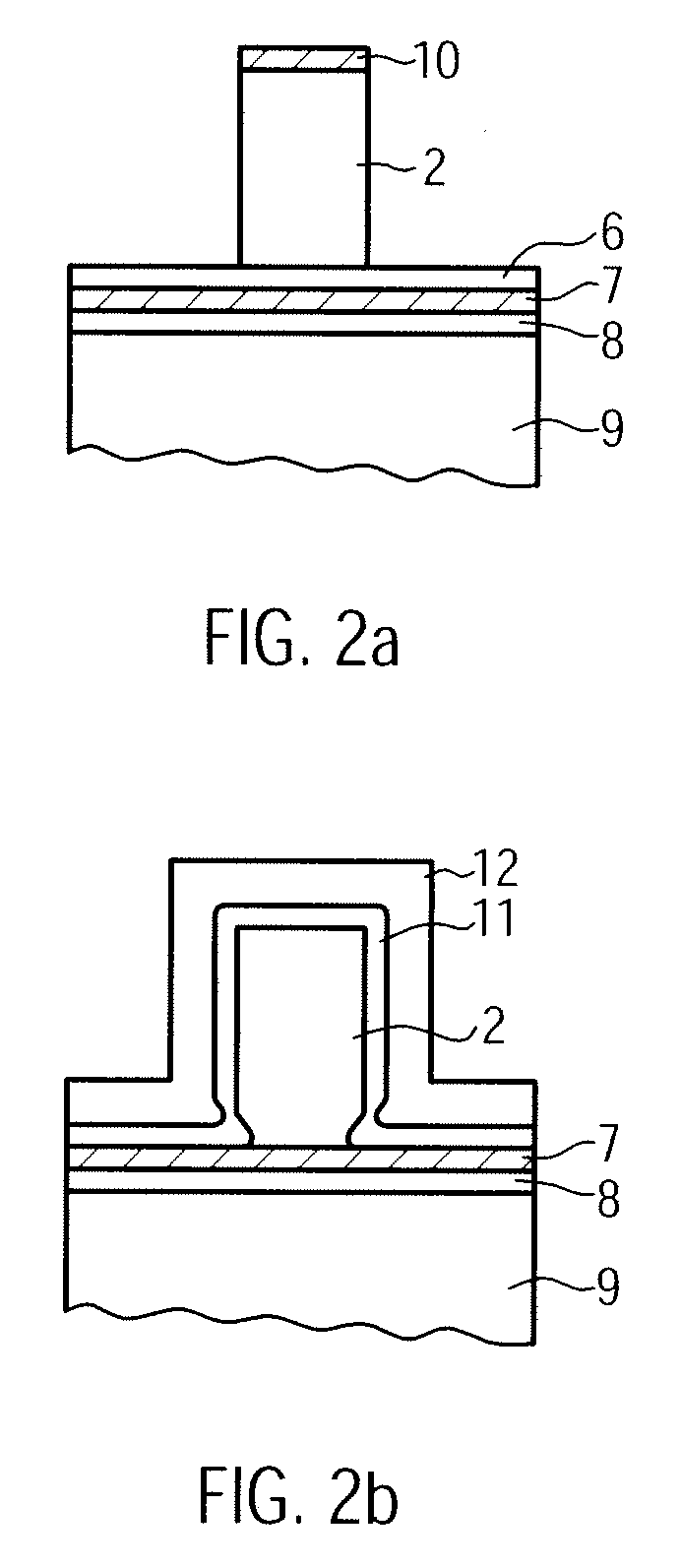Multiple gate field effect transistor structure and method for fabricating same
- Summary
- Abstract
- Description
- Claims
- Application Information
AI Technical Summary
Benefits of technology
Problems solved by technology
Method used
Image
Examples
first embodiment
[0036]FIG. 3 shows schematically a geometry of a fin 2 according to the present invention. The fin 2 is formed on the surface of a silicon nitride layer 7 with a thickness of 10 to 30 nm, the silicon nitride layer 7 being formed on top of an oxide layer 8 with a thickness of 70 to 80 nm.
[0037]During the formation of the fin 2, the underlying silicon nitride layer 7 acts as an etch stop and reduces, therefore, greatly the vertical recess V and the lateral recess and undercut of the fin 2. According to a particular example, it has been shown that the vertical recess V went to a 2 nm to 4 nm range from about 15 nm and that the horizontal recess was completely reversed. As a consequence of reversing of the profile of the lateral recess or undercut of the fin 2, the bottom corner profile of the fin 2 changes from rounded to tapered which might not be a desirable effect.
second embodiment
[0038]FIG. 4 shows schematically a geometry of a fin 2′ according to the present invention. The fin 2′ is formed on a layer stack consisting of a lower silicon oxide layer 8, a silicon nitride layer 7 and an upper silicon oxide layer 6 formed on top of the layer stack directly under the fin 2′. That means, in comparison to the example shown in FIG. 3, the top nitride layer 7 is replaced by the 10 nm to 15 nm range top oxide layer 6. By means of the upper silicon oxide layer 6, the advantage of rounded corners when etching and subsequently cleaning the fin 2′ during the fabrication process can be conserved. As shown in FIG. 4, there is not only a vertical recess V but also a horizontal recess H in the region under the fin 2′, leading to rounded corner formation at the bottom of the fin 2′. Moreover, the used layer structure keeps the benefit of perfectly controlling the fin 2′ vertical recess V by using the silicon nitride layer 7 as a hard etch stop when the silicon oxide layer 6, u...
third embodiment
[0039]FIG. 5 shows schematically a geometry of a fin 2″ according to the present invention. The fin 2″ is an improved variant of the fin 2′ of FIG. 4. The fin 2″ was well controlled over-etched in order to increase the undercut below the fin 2″. The larger horizontal recess H helps to round the bottom corners of the fins, which helps to improve the propagation of the gate electric field of the resulting FinFET 1 for a better back-gate effect.
[0040]FIG. 6 shows the same geometry of the fin 2″ according to the third embodiment of the present invention shown in FIG. 5, whereas the thickness of the upper silicon oxide layer 6 is reduced by half. This reduces by about the same value the horizontal recess H and helps to achieve a better compromise between recess profile and bottom corner rounding of the resulting fin 2′″.
H˜½TSi02Fin
The total height h variation of the fin 2′, 2″, 2′″ including the vertical recess V on each side of the fin 2′, 2″, 2′″ is given by the sum of the thickness T...
PUM
 Login to View More
Login to View More Abstract
Description
Claims
Application Information
 Login to View More
Login to View More - R&D
- Intellectual Property
- Life Sciences
- Materials
- Tech Scout
- Unparalleled Data Quality
- Higher Quality Content
- 60% Fewer Hallucinations
Browse by: Latest US Patents, China's latest patents, Technical Efficacy Thesaurus, Application Domain, Technology Topic, Popular Technical Reports.
© 2025 PatSnap. All rights reserved.Legal|Privacy policy|Modern Slavery Act Transparency Statement|Sitemap|About US| Contact US: help@patsnap.com



